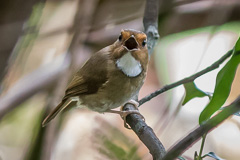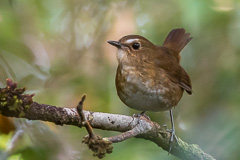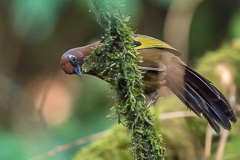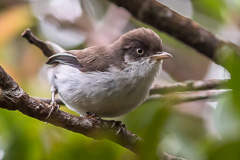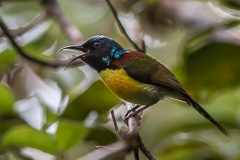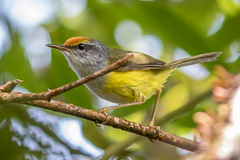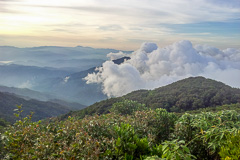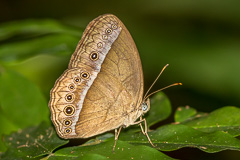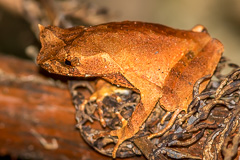Overview
Dates: |
4 - 8 May 2016 |
With Ian Dugdale and Games Punjapa Phetsri.
Due to its previous treatment as a race of Blue-throated Barbet Psilopogon asiaticus, together with difficulties of access at its remote location, the endemic Turquoise-throated Barbet Psilopogon chersonesus has long been ignored by the birding community. Although originally collected in 1927, to date only a handful of birders have ever seen this bird. However, with this taxon now treated as distinct, it becomes a highly range restricted and desirable Thai endemic. This bird is currently known only from the Khao Luang massif within the Khao Luang National Park in peninsula Thailand, above 800 metres, and hence isolated from the closest population of Blue-throated Barbet by more than 500 kilometres.
In July 2015 we attempted to locate Turquoise-throated Barbet on the adjacent peak of Khao Ramrom, also within the Khao Luang National Park, which at just under 1,000 metres altitude was assumed to hold the species. However, in four days, plus a subsequent visit, the bird was not found, presumably as insufficient good quality forest occurs on that mountain above 800 metres to hold a viable population.
The chief aim of this trip was to trek to the summit of Khao Luang, at 1,835 metres in search of the barbet, as well as Malayan Laughingthrush, known to occur there only at higher altitudes, and another species hard to access in Thailand. Additionally, it was an opportunity to look for around 25-30 other montane species rarely encountered in southern Thailand due to the problems of access over 300-400 metres above sea level. These included the like of Rufous-browed Flycatcher, Collared Owlet, Blue-winged Minla, Green-tailed Sunbird, Chestnut-crowned Warbler, Mountain Tailorbird etc. We decided to spend three nights on the mountain as this was a perfect opportunity to search for reptiles, mammals, butterflies and amphibians of higher altitude forest. |
When attempting to ascend Khao Luang, the three major issues to contend with are the weather, organisational logistics and physical fitness. The trail to the summit starts relatively gently, but the higher the ascent the steeper and more rugged the trail. In dry weather the climb can be considered a hard slog for the physically fit, in rain it should be considered difficult, slippery and dangerous. A minimum altitude of ascent, depending on starting point, is 1,200 metres. In dry weather if not birding, a fit person could trek to the summit in about 8-9 hours. At birding pace it is necessary to camp one to three nights on the mountain depending on species and wildlife being searched for.
To arrange a guide and porters for the trip there are two possibilities - either through the Khao Luang National Park headquarters with park rangers, or with local people from the village of Kiri Wong - the starting point for all treks. Although, in theory, it's possible to climb the mountain at any time of year, the park headquarters will not organise ascents during October, November and December due to potentially heavy rain. Hiring a local guide is not at all straightforward as no company officially organises treks; there being too little interest to justify it. Games had previously contacted local people in Kiri Wong in 2015 without success. As most potential guides are also farmers, any mountain work needs to fit in with crop cultivation demands. Our trip took considerable lead time to plan and arrange.
4 May. A five hour drive from Phuket to Kiri Wong, where we met with our guide, Lek, late afternoon so as to discuss final details and estimate the number of porters required for our equipment. We'd deliberately packed lightly, without tents, and minimised the amount of gear to essentials. Lek had originally estimated that two porters would be sufficient, but now discussion ensued. Evidently trekkers usually carry most of their own equipment and clothes, but we needed to be free of this to carry cameras and birding gear and to be free to bird with only day packs. So another porter was drafted in at late notice without problem. It was hard to imagine, given our small amount of gear, why three porters were required, but we were to find out later. Overnight at a local resort, as surprisingly Kiri Wong is somewhat touristic, based on having a cool flowing river run through town and extensive fresh fruit growing locally.
5 May. As today's trek, to the first camp, was relatively short we met Lek and the porters at 09:00. As might be expected it took a while for everything to be packed, but even longer for the off-road motorcycles to arrive. If trekking with park rangers the walk starts in the village. However, it's possible with good off-road bikes to ride on narrow, steep tracks through plantations and forest edge for five kilometres to start the trek at the forest proper. It would be fair to say that riding pillion on one of these bikes was the most dangerous part of our trip, and required total trust in the skill of the bike rider. One slip and we'd be head over butt down the hill. As well as cutting the trek by five kilometres it enables to start the walk in the shade of the forest at 630 metres altitude. However, it's clear that the last half kilometre of track is through plantation that has been cleared recently within the park boundary. Park staff turning a blind eye? We eventually started the walk at around 11:30 and plunged immediately into some good quality, tall evergreen forest.
The trail for the first hour, rising to 800 metres, was pretty tame, with few birds of interest. We heard our first Turquoise-throated Barbet at 730 metres, though impossible to locate. Initially Lek had thought of camping at this altitude by a river, but we decided to press on to 1,000 metres for our initial camp as we had time to spare and it would cut the hard day's climb tomorrow. This proved to be a good idea, as at this altitude the barbet suddenly became much commoner, outnumbering the other three barbets in the area - Golden-whiskered Barbet, Red-throated Barbet and Blue-eared Barbet. Intriguingly we also encountered Fulvous-chested Jungle Flycatcher here. |
Despite at least four Turquoise-throated Barbet singing in the immediate vicinity it took around an hour to find one in the high canopy. A few poor photos were obtained - a good start.
Whilst we were birding, the porters had done a good job of setting the campsite, putting up hammocks and tarpaulins, including fetching water from the small adjacent waterfall and had started to cook. Note that as it's not possible to carry anywhere near sufficient water it needs to be taken from streams along the way. The quality is evidently very good but we ran it through a purification filter just incase. Now we began to understand why three porters were required - one for the food, one for the alcohol and one for the remainder. Rum and moonshine were already being consumed by the guys well before evening. We discovered that seven and a half litres of the stuff had been carried up with us. Plus the bottles! Talking to Lek, it seemed that most treks are climbing and drinking parties and it was an eye-opener for them to have naturalists with them, who went walking with cameras at night in search of reptiles rather than getting drunk. In defence of the amount of food being carried up, the food turned out by our porter/cook was pretty good, although surely ten kilograms of rice was a little over the top. Especially as five kilos were taken back down. Needless to say no alcohol came back from the mountain. Although we crashed out at 21:00 the party guys went on till nearly 01:00 when they dropped where they were and threw up for good measure. Given this performance something was going to have to change the next night. Overnight Brown Wood Owl and Barred Eagle-Owl heard.
6 May. As we knew this was going to be a tough day, ascending from 1,000 metres to the summit at 1,835 metres we left camp early, following breakfast, leaving the guys to deal with the decamp and their hangovers. It took almost four hours to ascend to 1,400 metres, finding more Fulvous-chested Jungle Flycatcher, Hill Blue Flycatcher and Brown-cheeked Fulvetta at 1,200 metres. From here, in the following four hours, we started to encounter many of the true montane species, with Green-tailed Sunbird, Mountain Tailorbird, the very distinctive youngi race of Chestnut-crowned Warbler, Blue-winged Minla, Silver-eared Mesia, Rufous-browed Flycatcher and White-throated Fantail. Just short of the ridge almost at the summit, we encountered a pair of Malayan Laughingthrush, though photographing them proved nigh on impossible - pretty much the only shy bird we'd encountered on the mountain. |
The actual summit produced several more Green-tailed Sunbird, Lesser Shortwing, Malayan Laughingthrush and Turquoise-throated Barbet. Although this was deemed to be our campsite for the night, we let the guys camp there and set up our camp 200 metres farther back down the ridge - strongly hinting that they could party as much as they liked but we were going to have some sleep and peace. After dark we concentrated on moths and encountered a good number of smaller species, though finding any reptiles or mammals proved impossible - the area being so dry. During the day the lack of butterflies had been a major disappointment. A peaceful night with temperatures dropping to about 15°C.
7 May. Although we'd tentatively planned for two nights at the top, the dry conditions meant a lack of butterflies, reptiles, amphibians and mammals, so we thought a return to lower altitudes to camp by the river at 800 metres would offer more interesting possibilities. Before descending however, we further explored the ridge beyond the summit that passes through good looking cloud forest. A good number of montane birds were present here, as well as coming across a couple of piles of Tapir faeces. Around 11:00 we started the long descent, picking up Collared Owlet and a couple of butterflies along the way. The skies darkened considerably and it looked like we were in for some heavy rain, but after an hour or so they dissipated. Although we'd earmarked our stop at 800 metres, that camping area was already taken by a group of partying Thais, so we continued to the next stream where we camped at a 810 metres. Not an ideal campsite as most of it was on a slope, but a clear river and rocky outcrops looked interesting for wildlife. After dark we explored the surrounding forest and rocks in the river. An excellent collection of frogs and toads were discovered as well as Lekagul's Bent-toed Gecko. Fortunately tonight's party was more subdued and the noise from the river was sufficient to drown out any excess noise. 8 May. Early morning around the camp and river, hoping for damselflies and dragonflies but none really showed, so headed out slowly picking up a few skippers and butterflies in the taller forest before exiting the forest around midday. Another motorcycle ride back to the village. As we were pretty tired after three nights and days of heavy walking we were in no rush to drive back to Phuket, so took up Lek's offer of a night at his small farm on the edge of the park. This did entail yet another night of camping and getting back on the motorcycles, but a really peaceful location right next to a river, and as without electricity or shower it was straight into the river for a much needed cleanup. Great temperature and a very welcome wallow. Some interesting birds in the immediate vicinity included Malaysian Blue-banded Kingfsher, Brown-streaked Flycatcher, Banded Woodpecker and Green-billed Malkoha, the later not common in the south due to competition from Black-bellied Malkoha. |
Late afternoon the party guys turned up, with the remainder of the food plus a couple of crates of beer. Another party evening during which we had to send a bike out for yet more beer. In all a very successful trip, and we were impressed with the resilience and reliability of the team, despite the many hangovers, and enjoyed their company a great deal.
9 May. Return to Phuket.
Species List
| Khao Luang Trek | Count | Around Kiri Wong | Count | ||
| Great Argus | 1 | Asian Openbill | 2 | ||
| Crested Serpent Eagle | 2 | Chinese Pond Heron | 2 | ||
| Crested Honey Buzzard | 1 | Little Cormorant | 1 | ||
| Green-billed Malkoha | 2 | Spotted Dove | 4 | ||
| Barred Eagle-Owl | 1 | Greater Coucal | 4 | ||
| Brown Wood Owl | 3 | Green-billed Malkoha | 1 | ||
| Collared Owlet | 1 | Edible-nest Swiftlet | 20 | ||
| Himalayan Swiftlet | 10 | Malaysian Blue-banded Kingfsher | 1 | ||
| Orange-breasted Trogon | 2 | Red-throated Barbet | 4 | ||
| Red-headed Trogon | 1 | Banded Woodpecker | 1 | ||
| Golden-whiskered Barbet | 10 | Vernal Hanging Parrot | 4 | ||
| Red-throated Barbet | 10 | Large Woodshrike | 1 | ||
| Turquoise-throated Barbet | 25 | Dark-necked Tailorbird | 2 | ||
| Blue-eared Barbet | 15 | Common Myna | 10 | ||
| Maroon Woodpecker | 1 | Oriental Magpie-Robin | 2 | ||
| Vernal Hanging Parrot | 2 | Brown-streaked Flycatcher | 1 | ||
| Black-and-yellow Broadbill | 2 | Eurasian Tree Sparrow | 4 | ||
| White-bellied Erpornis | 12 | ||||
| Crow-billed Drongo | 1 | ||||
| White-throated Fantail | 3 | ||||
| Blyth's Paradise Flycatcher | 2 | ||||
| Grey-headed Canary-flycatcher | 6 | ||||
| Sultan Tit | 2 | ||||
| Black-crested Bulbul | 2 | ||||
| Asian Red-eyed Bulbul | 1 | ||||
| Ochraceous Bulbul | 8 | ||||
| Baker's Bulbul | 1 | ||||
| Mountain Bulbul | 2 | ||||
| Streaked Bulbul | 1 | ||||
| Cinereous Bulbul | 5 | ||||
| Mountain Tailorbird | 10 | ||||
| Arctic Warbler | 2 | ||||
| Chestnut-crowned Warbler | 6 | ||||
| Dark-necked Tailorbird | 6 | ||||
| White-browed Scimitar Babbler | 6 | ||||
| Pin-striped Tit-Babbler | 8 | ||||
| Brown-cheeked Fulvetta | 20 | ||||
| Streaked Wren-Babbler | 12 | ||||
| Abbott's Babbler | 1 | ||||
| Buff-breasted Babbler | 6 | ||||
| Malayan Laughingthrush | 8 | ||||
| Blue-winged Minla | 12 | ||||
| Silver-eared Mesia | 15 | ||||
| Hume's White-eye | 40 | ||||
| Asian Fairy-bluebird | 4 | ||||
| White-rumped Shama | 2 | ||||
| Rufous-browed Flycatcher | 3 | ||||
| Hill Blue Flycatcher | 3 | ||||
| Fulvous-chested Jungle Flycatcher | 4 | ||||
| Large Niltava | 5 | ||||
| Lesser Shortwing | 4 | ||||
| Chestnut-naped Forktail | 4 | ||||
| Little Pied Flycatcher | 10 | ||||
| Greater Green Leafbird | 1 | ||||
| Blue-winged Leafbird | 4 | ||||
| Fire-breasted Flowerpecker | 3 | ||||
| Green-tailed Sunbird | 30 | ||||
| Black-throated Sunbird | 12 |

